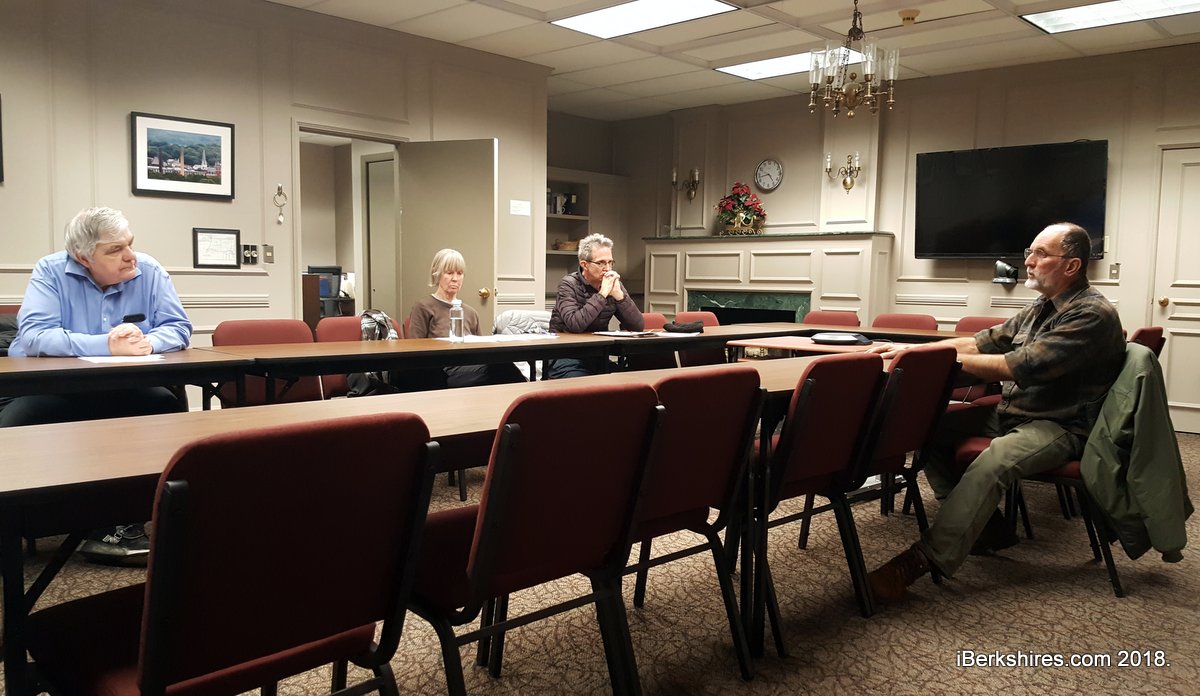BRPC Raises Concerns With Removal of Tel-Electric DamBy Andy McKeever, iBerkshires Staff
07:32AM / Sunday, December 09, 2018 | |
 The Tel-Electric dam is expected to be torn down, eventually. The Tel-Electric dam is expected to be torn down, eventually. |

Kenneth Egnaczak, on the right, weighed in on the matter saying the Tel-electric dam could power 70 homes if it is restored.
PITTSFIELD, Mass. — BRPC officials would like the state to consider reusing dams for power more often.
The comment comes from the organization's review of the removal of the Tel-Electric Dam on Mill Street.
In that long-awaited project, the state did not require that an alternative option of restoring the dam to generate power be explored.
"We understand that the secretary has not required an analysis of hydropower as part of this project, however, we also take this opportunity to again petition the commonwealth to require an analysis of the potential hydro-electric generating power of dams when state agency actions are involved in dam repair/rehabilitation or dam removals -- particularly those that receive public funding," reads drafts of Berkshire Regional Planning Commission's comments on the environmental review report regarding to removal of the dam.
"This is particularly important given the Massachusetts Supreme Judicial Court's decision station that the commonwealth is falling short of meeting the mandates of the Global Warming Solutions Act."
The 18-feet high and 40-feet wide dam has been in line to be demolished for a number of years. An inspection in 2000 found it to be a low-hazard dam in poor condition. It is attached to the Hawthorne Mill building and the state has pieced together more than $2 million to remove the dam.
BRPC Commissioner Roger Bolton personally doesn't see how using that particular dam for hydropower makes economic sense, but he'd like to see BRPC reiterate to the state that hydropower should be considered.
"The possibilities for hydro just aren't there," Bolton said of that project, leading to a split response on whether or not BRPC should include the comments regarding hydropower.
Kenneth Egnaczak disagrees with Bolton's assessment. Egnaczak owns the Cheshire Harbor dam and brought it back into operation just a few years ago. He said the Tel-electric dam is the same size as his and can generate enough power for 70 homes.
"They both have the same potential," Egnaczak said.
Egnaczak expounded on the benefits of water, saying it continually offers power, unlike solar or wind that stops producing when the sun isn't shining or breeze isn't blowing. He added that there is still pollution being generated and dumped into the river and the dam is able to stop the sediments from continuing downstream until they can be cleaned out later.
But he said state and federal officials haven't made it easy for hydropower generators as they have for solar or wind. While those projects receive tax credits and easy permitting, Egnaczak said it takes some nine years to get a dam up and running and is much more costly and regulated. He said most of the dams in the state were designed to produce power but only a small percentage of them still are.
He added that new dam designs address concerns environmentalists have raised regarding the migration of fish and soil.
As for the Tel-electric dam, Egnaczak said he's reviewed the inspection report and the dam doesn't have any structural issues. He said the grate at the bottom had failed years ago but that can be repaired.
"It will not fall down," he said, praising granite and arched construction.
The Environmental Review Committee also raised questions about the owner's responsibility. The Nash family owns and uses the Hawthorne Building but BRPC officials do not see where they are contributing to the project.
"We are concerned with the apparent lack of financial commitment to the project from the dam owner who, like every other dam owner across the state, has a legal responsibility to maintain the structural integrity of their dam," read BRPC's comments.
"The owner of the dam has apparently tried for years to convince the city of Pittsfield to accept ownership. The city has, however, dedicated a great deal of staff time and effort to the project, identifying possible funding sources, writing grants, and bringing the funding and technical assistance together and is continuing to 'fundraise.'"
BRPC is using the state to ensure that the city has no liability while handling the work and to "get a financial commitment from the dam owner that would at a minimum cover the cost of reinforcing and stabilizing the foundation of the mill building that he owns."
BRPC said the foundation of the building is deteriorating and the owner should be taking care of that at the time the dam is being removed.
That led to further questions from Commissioner Mark Smith as to the future maintenance and ownership of areas around the dam after it is removed and where liabilities for the work done by the city lay. Planner Melissa Provencher said she was told there are provisions in the documentation to hold the city harmless but she didn't have the answer on future ownership. Provencher said she'd see to that information prior to the executive committee's vote on the comments.
The ownership of the railroad bridge also raised concerns. Provencher said it isn't known who owns the bridge and that the abandoned structure is no longer part of the plans. It is set to stay where it is.
Commissioner Edward Holub said the bridge is particularly an attraction for criminal activities. The organization Citizens for PCB Removal had previously written to the state about those concerns, questioning the city's plan to enhance public access to the river in that location while being blocked by private properties make it difficult for the city to police.
Bolton didn't feel those questions were appropriately addressed in the plan.
"The hope would be if it became a nice area, there would be good people there all of the time," Holub said.
Despite some lingering concerns, BRPC is much happier with the latest plan than the prior one. In previous iterations, only a third of the 9,000 cubic yards of contaminated soil from behind the dam were to be removed. Now, all of it is to be removed.
"That was a significant concern of ours at the time," Provencher said. "The major change is they are no longer going to leave 6,000 yards to passively migrate downstream."
| 
 MEMBER SIGN IN
MEMBER SIGN IN
 MEMBER SIGN IN
MEMBER SIGN IN